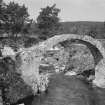Carrbridge, Old Bridge
Road Bridge (18th Century)
Site Name Carrbridge, Old Bridge
Classification Road Bridge (18th Century)
Alternative Name(s) Carr Bridge, Old Packhorse Bridge Over River Dunain; River Dulnain; 'funeral Bridge'
Canmore ID 15453
Site Number NH92SW 12
NGR NH 90635 22928
Datum OSGB36 - NGR
Permalink http://canmore.org.uk/site/15453
- Council Highland
- Parish Duthil And Rothiemurchus
- Former Region Highland
- Former District Badenoch And Strathspey
- Former County Inverness-shire
NH92SW 12 90635 22928
For successor bridge (adjacent to E), see NH92SW 21.
Reference: National Buildings Record
Country Life, April 18th 1939, p.367
(Undated) information in NMRS.
Built 1717. High single span humpback rubble bridge over River Dulnain; tooled rubble arch springing from natural rock abutment. Neither surfacing nor parapet survive.
T Ruddock 1979.
This bridge formerly carried a road over the River Dulnain at the N end of the village of Carrbridge (NH92SW 23) and to the W of the former line of the A9 public road (now the B9153). It is depicted, but not noted, on the 1982 edition of the OS 1:10,000 map.
Information from RCAHMS (RJCM), 28 March 2006.
Reference: National Buildings Record - Country Life, April 18th 1939, p.367
Construction (1717)
Built in 1717 by John Niccelsone, Mason. It had a width between parapets of 7 ft.
R Paxton and J Shipway, 2007.
Publication Account (2007)
Carr Bridge
Historic Engineering Works no. HEW 2532
The remains, mainly the arch-ring, of a rubble stone almost semicircular arch bridge over the Dulnain, built in 1717. It had a width between parapets of 7 ft and the steepness of the roadway at each side of the arch indicates that the bridge was intended for pedestrian and horse usage. It is said to have been known as a funeral bridge because it facilitated the carrying of coffins to the burial ground and was reputed to have been built at the expense of the Parish by John Niccelsone, a mason, and cost £100.
Sir Owen Williams’ slender reinforced concrete openframe arch bridge of the 1930s (NH92SW 21.0), was replaced by the present bridge.
R Paxton and J Shipway, 2007.
Reproduced from 'Civil Engineering heritage: Scotland - Highlands and Islands' with kind permission from Thomas Telford Publishers.
External Reference (2011)
Plaque at the bridge reads:
'At the beginning of the eighteenth century, to the inconvenience of both travellers and local people, there was no point at which the River Dulnain could be crossed when it was in spate, and burials at the Church of Duthil were often delayed.
Brigadier-General Alexander Grant of Grant, Clan Chief, commissioned John Niccelsone, a mason from Ballindalloch to build a bridge at Lynne of Dalrachney. Built between May and November 1717, the bridge was paid for out of stipends of the Parish of Duthil.
Its parapets and side walls were badly damaged in the 18th century and again in the famous flood of 1829, giving the appearance it still has today.'
Information from the ARCH Community Timelines course, 2011






























































